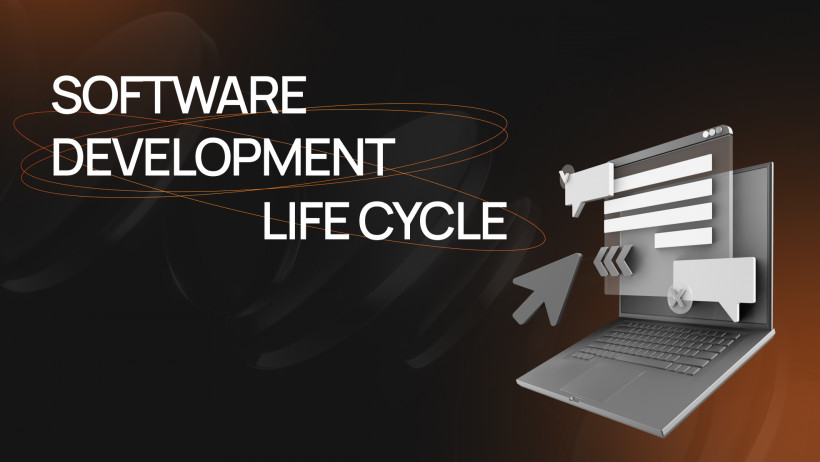When you set out to build software, it’s easy to get lost in code, shifting requirements, tight deadlines, and endless iterations. Even experienced teams can feel overwhelmed without a structured approach. That’s why every successful project follows a roadmap, and that’s where the software development life cycle (SDLC) comes in.
Think of SDLC as the GPS for your product journey. It not only shows the path from the spark of an idea to a live, functioning application, but also warns you about potential roadblocks along the way. With it, teams can align on goals, track progress, and keep quality under control. Without it, projects risk budget overruns, missed deadlines, or software that simply doesn’t meet user needs.
In this article, we’ll dive into the SDLC phases, explore the most popular SDLC models, and uncover best practices that can help you avoid common pitfalls. By the end, you’ll see how a well-executed SDLC can transform software chaos into predictable, successful delivery.
The software development process is much more than a checklist of tasks. It’s a structured methodology that guides teams through every step of building software: from the initial planning stage to long-term maintenance. By breaking the work into well-defined SDLC stages, teams avoid chaos and create products that are not only functional but also aligned with business strategy.
Instead of diving straight into coding, SDLC encourages teams to pause, analyze, and design before writing a single line of code. This systematic approach ensures that projects are well-organized, cost-effective, and future-ready. Whether the goal is to launch a small MVP or roll out a large-scale enterprise solution, SDLC provides a reliable framework for success.
What Is the Software Development Life Cycle (SDLC)?
Purpose and Benefits
Why does SDLC matter so much? Because it brings clarity and structure to complex projects:
- Clear visibility into project scope, deliverables, and timelines.
- Early identification of risks and bottlenecks, reducing costly surprises.
- Improved collaboration between developers, QA engineers, designers, and business stakeholders.
- Higher product quality thanks to systematic testing and QA at multiple levels.
- Predictability and scalability, making it easier to manage resources and plan long-term growth.Who Uses SDLC?
The beauty of SDLC is that it scales. From startups building MVPs under tight deadlines to enterprises designing mission-critical systems, nearly every organization engaged in software development leverages some variation of SDLC. It creates a common language between technical and business teams, standardizes the software development process, and makes projects more adaptable in an ever-changing market.
The SDLC phases act like stepping stones — each one builds on the last, ensuring the project moves forward smoothly and logically. Skipping a step or rushing through it can cause issues later, so understanding each stage is key.
The 7 Core Phases of SDLC
/1.png)
1. Planning
This phase sets the foundation for success. Teams define project goals, assess feasibility, allocate resources, and estimate costs. Clear planning avoids scope creep and ensures everyone knows what they’re working toward. Early stakeholder involvement here is critical: business leaders, end-users, and technical experts all contribute to shaping the vision.
2. Requirements Analysis
Often called requirement analysis, this phase is all about listening and documenting. Functional requirements (what the system should do) and non-functional requirements (performance, security, usability) are collected. Poorly defined requirements are one of the most common reasons for project failure, so investing time here saves effort later.
3. System Design
Here, the “blueprint” of the system takes shape. Architects define system structure, databases, and workflows, while designers create intuitive UI/UX experiences. A well-thought-out system design bridges the gap between business goals and technical implementation, providing developers with a clear roadmap.
4. Development (Coding & Implementation)
This is where ideas become reality. Developers write code according to the design specifications, often using agile sprints or iterations. Best practices like version control, coding standards, and peer reviews ensure quality and consistency. Collaboration tools keep teams aligned, especially in distributed environments.
5. Testing
Before release, software must be validated. QA teams run unit, integration, system, and user acceptance testing (UAT) to ensure everything works as intended. Automated testing accelerates the process, but manual testing still plays a role in spotting usability issues. Skipping or rushing testing can result in costly bugs that damage user trust.
6. Deployment
Once tested, the software is rolled out into production. Deployment strategies vary: some teams prefer a big-bang release, while others use phased or staged rollouts to minimize risk. Modern approaches often rely on CI/CD pipelines for smooth, repeatable deployments.
7. Maintenance & Support
The journey doesn’t end at deployment. Software requires ongoing monitoring, bug fixes, updates, and performance tuning. This phase also includes responding to user feedback and scaling the system as usage grows. Continuous support ensures the product stays relevant and reliable in the long run.
Popular SDLC Models
/2.png)
Different projects call for different approaches, and no single method works for every team. That’s why multiple SDLC models exist, each offering its own way to structure and manage the development process. Choosing the right one depends on factors like project size, complexity, budget, and how much flexibility is needed. Let’s look at the most common models in practice:
Waterfall
A classic, linear, step-by-step model where one phase must be completed before the next begins. It’s straightforward and easy to manage, making it suitable for projects with clear, fixed requirements and little expected change. However, it can be rigid and less responsive to evolving needs.
Agile
An iterative, flexible model that emphasizes collaboration and adaptability. Teams work in short sprints, delivering small increments of working software. Continuous feedback and regular adjustments make Agile SDLC a strong fit for startups, MVPs, and fast-paced markets where customer needs evolve quickly.
Iterative
Instead of building the product all at once, the iterative model develops it in repeated cycles. Each cycle delivers a working version that can be tested and improved. This allows teams to refine features gradually and incorporate feedback without waiting for the final release.
Spiral
A hybrid approach that combines iterative development with a strong focus on risk assessment. The product is developed in loops, with each cycle involving planning, risk analysis, development, and evaluation. It’s best suited for large, high-risk projects where safety, compliance, or budget concerns require extra caution.
DevOps Lifecycle
A modern model that integrates development and operations into a single, continuous cycle. It emphasizes automation, CI/CD (Continuous Integration and Continuous Deployment), and collaboration between dev and ops teams. DevOps integration accelerates delivery, improves reliability, and supports fast scaling, especially valuable for SaaS platforms and enterprise systems.
SDLC in Agile vs Waterfall
Two of the most popular software development approaches are Waterfall and Agile. Each has its own strengths and weaknesses, and the right choice depends on your project goals, complexity, and flexibility needs.
| Aspect | Waterfall SDLC | Agile SDLC |
|---|---|---|
| Process | Sequential — each phase must be completed before moving to the next. | Iterative and incremental — development happens in short sprints. |
| Requirements | Defined upfront and remain mostly unchanged. | Flexible and adaptive, evolving during the project. |
| Delivery | One major release at the end of the cycle. | Frequent small releases delivering value continuously. |
| Feedback | Comes late in the cycle, often during testing or after release. | Continuous feedback throughout development. |
| Best for | Projects with clear, stable requirements and little expected change. | Dynamic, fast-changing projects where adaptability is crucial. |
| Risk Management | Risks identified late, making fixes more costly. | Risks addressed early and incrementally at each sprint. |
| Team Collaboration | Formal communication, more hierarchical. | Close collaboration with daily stand-ups and active stakeholder involvement. |
The takeaway: Waterfall brings structure and predictability, while Agile offers flexibility and speed. Many modern teams combine both, creating hybrid approaches that fit their unique project needs.

Best Practices for a Successful SDLC
To maximize efficiency and quality, follow these SDLC best practices:
- Early stakeholder involvement – align expectations from the start.
- Automated testing – speed up QA and catch bugs earlier.
- Regular code reviews – improve code quality and knowledge sharing.
- Documentation at every phase – prevents misunderstandings and supports scalability.
Common Pitfalls to Avoid
Even with the best intentions, SDLC projects can go off track. Avoid these mistakes:
- Unclear requirements – leads to costly rework.
- Skipping testing cycles – results in unreliable software.
- Poor communication between teams – creates delays and misalignment.
How to Adapt SDLC to Your Project Type
Not all projects are created equal. Tailor your approach:
- Custom products – require thorough planning and flexible design.
- MVPs – focus on speed and core functionality; Agile works best.
- SaaS platforms – benefit from iterative models and strong DevOps integration.
- Enterprise systems – demand detailed documentation, testing, and often hybrid models.
Conclusion
The software development life cycle (SDLC) is not just a theoretical framework, it’s the backbone of predictable, high-quality software delivery. By breaking down the journey into clear stages, it helps teams stay organized, reduce risks, and ensure that the final product aligns with both business goals and user needs.
Whether you work with a Waterfall approach for projects with stable requirements, adopt Agile for dynamic environments, or embrace DevOps for speed and automation, the real power of SDLC lies in adapting it to your project’s unique context. Combining the right model with proven best practices (from early stakeholder involvement to continuous testing and effective communication) can dramatically increase the chances of success.
If your goal is to bring clarity, efficiency, and long-term reliability into your next development project, adopting the right SDLC strategy could be the game-changer.
Ready to explore how our team can help you streamline the process, minimize risks, and deliver software that truly works? Let’s talk!

